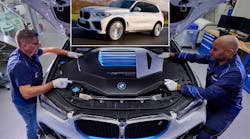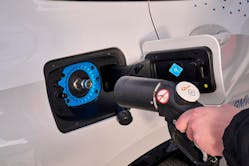What you'll learn:
- What's going into the new hydrogen-powered vehicles.
- Creation and manufacturing of the fuel-cell stack.
- Details about BMW's new manufacturing facility.
Ground zero in the war to win the hearts and minds of car buyers is finding a viable alternative to fossil-fuel-powered vehicles. Hydrogen offers potential as a future energy source and can become a long-term technology option for emission-free mobility, alongside battery-electric power.
To that end, and in a peacock-like spreading of its hydrogen feathers, the BMW Group has unveiled the first vehicles in a hydrogen pilot fleet that will go into service this year after four years of development work.
The fleet of under 100 vehicles will be employed internationally for demonstration and trial purposes for various regulatory bodies and marketing endeavors. In particular, BMW needs to convince lawmakers that hydrogen is a viable alternative to electric technology.
This active driving experience will be the first chance for people not involved in the development process to gain a direct impression of what the BMW iX5 Hydrogen has to offer. Only a small handful will come to the United States, in part because unlike Europe and parts of Asia, hydrogen infrastructure can’t be found outside of California.
“Hydrogen is a versatile energy source that has a key role to play in the energy transition process and therefore in climate protection. After all, it is one of the most efficient ways of storing and transporting renewable energies,” said Oliver Zipse, Chairman of the Board of Management of BMW AG. “Hydrogen is the missing piece in the jigsaw when it comes to emission-free mobility. One technology on its own will not be enough to enable climate-neutral mobility worldwide.”
Building the Cars
BMW Group’s plant in Spartanburg, S.C. supplies the base vehicles for the hydrogen model, which was developed on the platform of the BMW X5. They’re first fitted with a new floor assembly that makes it possible to accommodate the two hydrogen tanks in the center tunnel and under the rear seat. The model-specific 12- and 400-V electrical systems battery, electric motor, and fuel cell are all integrated during the assembly stage, alongside standard production parts.
Positioned in the rear axle area together with the battery, the electric motor is a product of the current, fifth-generation BMW eDrive technology also employed in battery-electric and plug-in hybrid models from BMW. The electric motor, transmission, and power electronics are grouped together in a compact housing; a power battery with lithium-ion technology has been developed specially for this vehicle.
The powertrain channels a maximum output of 295 kW/401 hp onto the road. In coasting and braking phases, the motor also serves as a generator, feeding energy back into the power battery.
The BMW Group sources the individual fuel cells from the Toyota Motor Corporation. The two companies have been collaborating on fuel-cell drive systems since 2013.The fuel-cell system has been manufactured at BMW’s in-house center for hydrogen in Garching to the north of Munich since August of this year.
Fuel-Cell Details
A chemical reaction takes place in the fuel cell between gaseous hydrogen from the tanks and oxygen from the air. Maintaining a steady supply of both elements to the fuel cell’s membrane is crucial to the drive system’s efficiency. The hydrogen needed to supply the fuel cell is stored in two 700-bar tanks made of carbon-fiber reinforced plastic (CFRP). Filling up the hydrogen tanks takes three to four minutes.
In addition to the technological equivalents of features found on combustion engines, such as charge air coolers, air filters, control units and sensors, the BMW Group also developed special hydrogen components for its new fuel-cell system. These, for example, include a high-speed compressor with turbine and a high-voltage coolant pump.
Together the two tanks hold almost 6 kg of hydrogen pressurized to 10,150 psi, enough to give the BMW Hydrogen a range of 504 km (313 miles) in the European WLTP cycle (about 260 miles of range in the U.S. test, as measured by the EPA cycle). In the vehicle, one read-out tracks real-time hydrogen consumption; another helps the driver find the nearest fueling station.
Manufacturing the Fuel-Cell Systems
Fuel-cell systems are manufactured in two main steps. The cells are first assembled into a fuel-cell stack. The next step involves fitting all of the other components to produce a complete fuel-cell system. Stacking of the fuel cells is largely an automated process. Once the individual components have been inspected for any damage, the stack is compressed by machine with a force of five tons and placed in a housing.
The stack housing is manufactured in the light metal foundry at BMW Group’s Landshut Plant using a sand-casting technique. For this, molten aluminum is poured into a mold made from compacted sand mixed with resin in a process specially designed for this vehicle. Final assembly of the fuel cell stacks includes a voltage test along with extensive testing of the chemical reaction within the cells.
In the last stage, all of the different components are fitted together in the assembly area to produce the complete system. During this system assembly stage, further components are fitted, such as the compressor, the anode and cathode of the fuel-cell system, the high-voltage coolant pump, and the wiring harness.
The BMW Group’s pilot plant at its Research and Innovation Centre in Munich is the interface between development and production where every new model from the company’s brands is made for the first time.
Around 900 people work in the body shop, assembly, model engineering, concept vehicle construction and additive-manufacturing facilities. Numerous components are produced exclusively for the hydrogen-powered vehicle, including some made at the Additive Manufacturing Campus—the BMW Group’s center for 3D printing.
The BMW Hydrogen passes through all of the customary stages of production, starting at the body shop, then proceeding to the paint shop and assembly, before ending with a final inspection of each individual vehicle. Following this, every vehicle undergoes an operational check at the BMW Group’s test center in Aschheim.
By the Numbers
BMW claims acceleration to 62 mph is around six seconds and top speed is 112 mph. Here’s some of the key technical data:
- Maximum output of overall drive system: 295 kW/401 hp
- Electric continuous output of the fuel-cell system: 125 kW/170 hp
- Maximum output of the battery (Lithium-ion technology): 170 kW/231 hp
- Maximum output of the highly integrated electric drive unit: 295 kW/401 hp
- Capacity of the hydrogen tanks: 6 kg hydrogen (gaseous)
- Acceleration 0-100 km/h (62 mph) < 6 s
- Top speed: Over 180 km/h (112 mph)
- Hydrogen consumption in the WLTP cycle: 1.19 kg/100 km
- Range in the WLTP cycle: 504 km (313 miles)
All of these hydrogen-based developments hopefully signify a page turned in the book of vehicle advancement. BMW views hydrogen fuel-cell technology as an attractive complementary alternative to the battery-electric drive system. This is especially true for customers for whom short refueling stops and long range are a must.
Conclusion
The BMW Group sold more than 215,000 fully electric vehicles worldwide in 2022, which represents an increase over the previous year of almost 108%. Fully electric vehicles accounted for just under 9% of total sales volumes last year, and this share is set to increase to 15% in 2023.
By 2030 at the latest, the BMW Group is looking to reach a situation where fully electric vehicles claim a more than 50% share of overall sales. It’s part of the company’s plan to reduce CO2 emissions per vehicle over its full lifecycle—supply chain, production, and use phases—by at least 40% by 2030 compared with 2019.
Yet as BMW Board Chairman Zipse points out, “You already see that in 2027 or 2028, there will be a scarcity of raw materials (needed to build EVs) if we continue to ramp up production. So, that’s where hydrogen comes in.” He adds, “It uses less raw materials, it’s a much, much smaller battery, the car is lighter, and it does not need the same charging infrastructure.”
For these reasons, BMW believes that hydrogen will merge into the automotive mainstream during the second half of the 2020s.



